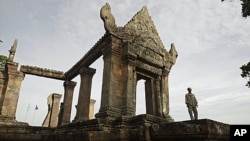Preah Vihear temple, which sits on a high cliff near the Thai border, has been the center of confrontation between Cambodia and Thailand for years.
These days, quiet—and tourists—have returned to the temple. John Burgess, a former Washington Post reporter who has written a book about the temple and the conflicts over it, revisited the site recently to learn where things now stand.
In an interview at the temple with VOA Khmer, Burgess said both governments may find it difficult to create lasting peace near the temple, because it has emotional significance to both Thai and Cambodian groups.
Erected on the cliff of the Dangrek Mountains, the 11th-century Preah Vihear temple was once located at the center of Khmer empire.
“This this temple is very unusual among the Khmer temples,” Burgess, author of “Temple in the Clouds,” said. “It’s on top of a large natural mountain, and it was built by several kings. It’s laid out from north to south and along a linear design, rather than a square design.”
The temple was originally dedicated to Shiva—the Hindu god. According to Burgess, Cambodian ancestors shaped the naturally occurring sandstone of the mountains to build the temple—now a Unesco World Heritage Site.
“When this temple was built, starting about a thousand years ago, it was deep inside the Khmer empire,” he said. “In subsequent centuries’ border changes, it came to find itself right at the border of two countries that do not trust each other very much—Thailand and Cambodia.”
The International Court of Justice in 1962 determined the temple itself sat on Cambodian soil, but a dispute of ownership of the land surrounding the temple followed, culminating in a protracted military standoff between Cambodia and Thailand in 2008. In 2013, the International Court determined that Cambodia retained sovereignty over the entire promontory on which the temple sits, and Thailand withdrew its troops.
Preah Vihear has again become a popular tourist destination. For visitors like Hem Sopheareak, a member of the Interfaith Cooperation Forum, who took a tour group to the temple recently, the renewed peace and quiet at the temple was a good thing.
“For my own suggestions, I would like both governments to consider both people’s interests before deciding to do anything,” he said. “Any actions would not bother the government, but people would not sleep to hear the explosions, and how could they feed their children and wives?”
Burgess said the two governments should work together to ease the nationalism that has led to conflicts in the past.
“It is not something that the government can do just by negotiation and agreements, because there’s very strong emotion in the populations of both countries,” he said. “Some people have suggested a joint history text book, the way Germany and France have adopted text books. Other suggestions are more exchange of students and more cross-border travel, so that over time Cambodians and Thais come to recognize how much they share of heritage, as opposed to how much separates them.”









